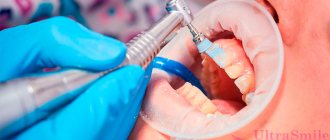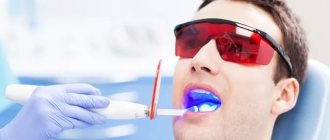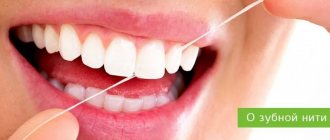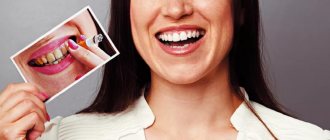May 22, 2020
An increasing number of people are convinced that professional teeth cleaning at the dentist, which should be done several times a year, helps keep teeth in order and helps prevent oral diseases. But doctors warn that good results can only be obtained when hygiene is carried out in a comprehensive manner. What stages should it consist of? Not everyone knows about this, so journalists from the editorial office of the UltraSmile.ru portal offer to examine the issue in detail in today’s material.
Stage No. 1. Preparation
First, the doctor prepares the patient for professional cleaning. The specialist conducts a short survey and then examines the oral cavity to identify any contraindications and assess the clinical situation. At this stage, it is very important to establish whether the patient is allergic to the components of the drugs that will be used during the procedure and to local “freezing”, whether there is asthma, breathing problems, or chronic diseases.
The doctor also needs to understand whether there are crowns, dentures, implants, fillings in the mouth, and whether there are non-carious defects and inflammations on the mucous membrane. It is important for women to tell their doctor if they are pregnant. Depending on the clinical situation and related factors, the doctor will regulate the force of the devices used and select the appropriate means to ensure hygiene is carried out in the most gentle, safe and effective manner.
Before the procedure, the patient is put on a special cap and protective glasses.
Next, the patient is given a special cap and protective glasses, which must be put on before brushing their teeth. You need to know that this is a procedure during which splashes and powder may come into contact with your face, hair and clothes. Therefore, try to come to it in the most simple and comfortable clothes, without complex makeup and intricate hairstyle, so as not to be upset later.
What is professional teeth cleaning? This is a set of measures aimed at removing all types of plaque from the enamel and from under the gums. As a result, the natural color and healthy shine of the enamel returns, bad breath goes away, and teeth and gums become stronger.
Before the procedure, many people wonder whether it hurts to have professional teeth cleaning done. We hasten to please you: it is not painful, since at the preparation stage the specialist will treat the oral cavity with a special anesthetic gel.
What is professional teeth cleaning at the dentist?
Oral care can be done both at home and in the dentist's office. Daily home care does not completely eliminate the risk of oral diseases. Therefore, during regular dental examinations, you should periodically have your teeth professionally cleaned.
Modern cleaning methods allow you to remove all plaque from the enamel and remove existing tartar in a short time. At the same time, the teeth are restored to their natural whiteness and various oral diseases are prevented.
The professional teeth cleaning procedure is painless. Its main advantage, in addition to the removal of visible dental plaque, is the reduction of pathogenic microflora in the oral cavity and the increase of local immunity.
What is plaque and tartar?
Dental plaque is essentially a mass of food debris, saliva, pathogenic microorganisms and their waste products. Daily brushing removes plaque only on open and easily accessible areas of the teeth. In places that are difficult to clean independently, plaque accumulates in large quantities. This is, first of all, the cervical area of the teeth, fissures on the chewing surface and the gingival groove.
After a few days, the plaque turns into a hard plaque. The concentration of harmful microorganisms in it is 50% higher than in unhardened plaque. Such a plaque cannot be washed off with saliva or water. The plaque gradually grows and a very dense deposit is formed from it - tartar. This education contributes to the development of periodontal diseases (periodontitis and periodontal disease) and caries.
Stage No. 2. Removal of hard dental plaque with ultrasound
The examination was carried out, the glasses were put on, the “freezing” began to take effect. Now what? The doctor begins cleaning your teeth using an ultrasonic scaler (scaler or scaler). The photo shows how this happens.
The photo shows an ultrasonic scaler
The specialist brings the tip of the device to the areas being treated, but does not touch them, that is, cleaning is carried out without contact. Microvibrations pass through the tip, which affect hard deposits, cause them to move away from the teeth and literally crush the stone into many small particles. In parallel with ultrasound, water is supplied to the oral cavity, cooling the enamel and preventing the risk of overheating, as well as washing away deposits that have lagged behind hard tissues.
Read the article on the topic “7 problems that professional teeth cleaning can solve.”
Some clinics may offer you laser treatment instead of ultrasound treatment. This is considered safer and more gentle. In addition, the laser does not cause any discomfort at all and additionally disinfects the oral cavity. But using a laser is more expensive.
Stage No. 3. Removing soft deposits using Air-Flow
Doctors say that it is brushing teeth using the Air-Flow water-abrasive technology that makes it possible to lighten the enamel by 1-2 tones and polish it. Don't believe me? See before and after photos. The result is obvious! "Air-Flo" fights soft pigmented deposits formed after eating food and drinks with dyes, with a smoker's plaque. After the procedure, the teeth acquire their natural shade, become smooth and shiny.
The photo shows teeth before and after cleaning with the Air-Flow system
The procedure can be performed without ultrasound, but when combined with it, it is much more effective. To carry it out, you need a device into which a special fine soda-based powder is filled, as well as water. While performing Air-Flow, some patients report a feeling of slight coolness in their mouth. After Air-Flo, the unpleasant odor disappears, and your breath becomes fresh, since the powder contains different flavors (mint, cherry, peach, lemon).
Read the article on the topic “6 interesting facts about Air-Flow whitening.”
Air Flow teeth cleaning
Removal of dense plaque that forms on teeth is carried out using the modern Air Flow system. This is a kind of powerful aerosol, which is supplied through a tip using a strong air stream and consists of a liquid and a special powder. It is very important what powder is used for cleaning. We use innovative Erythritol powder, which does not change the structure of the enamel surface. Patients will notice that Air Flow brushing has a brightening effect - teeth become one or two shades whiter. In fact, it is the enamel that acquires its natural smoothness and shine.
Stage No. 4. Cleaning subgingival deposits with hand instruments
This stage is not for everyone, but only for those who have a large amount of plaque under their gums. This usually happens if a person rarely undergoes professional teeth cleaning or has never had one in his life and does not know what it is. Or when a patient has periodontitis and periodontal disease, accompanied by the formation of deep periodontal pockets (the gums peel off from the teeth) and the rapid accumulation of abundant bacterial deposits in them.
With closed curettage, periodontal pockets are cleaned with special hooks
The procedure is performed manually using special devices called curettes. Curettes are hand-held instruments with a hook at the end. With their help, the doctor mechanically removes deposits that could not be removed with ultrasound and Air-Flo. There are several methods of curettage - open and closed.
Comprehensive professional oral hygiene
Occupational hygiene is carried out by a dental hygienist, who must have the appropriate license to provide this specialized service. On the Internet, many patients ask the same question: “Why do we need professional oral hygiene?” If we brush our teeth twice a day, why should we go to the doctor for it and pay extra money? The thing is that a toothbrush and toothpaste do not remove all deposits: even with an ideal cleaning technique, hard-to-reach areas remain where soft plaque accumulates. Under the influence of calcium salts, plaque turns into tartar, which is almost impossible to remove without special devices. Professional hygiene is especially important for people with braces and dentures.
What is included in professional teeth cleaning?
- Preventive examination of the oral cavity
- Tartar removal
- Cleaning teeth from plaque in hard-to-reach places
- Polishing tooth surfaces, veneers, crowns, etc.
- Fluoridation
Stage No. 5. Polishing the enamel
In order for professional teeth cleaning to be truly effective, and for the difference between what happened before and what happened after to remain as long as possible, it is necessary to carry out the enamel polishing stage. Why is it important? The structure of the enamel is heterogeneous and porous; it contains all sorts of cracks and microcavities into which bacteria and pigment can easily penetrate. After ultrasound and Air-Flo, the enamel again loses its protective film and acquires roughness, which becomes a favorable environment1 for the re-accumulation of plaque. They need to be eliminated. If you do not make hard tissues smooth, they will quickly begin to attract and collect soft food deposits, bacteria, and food dyes.
“I have never done prof. brushing my teeth, and two years ago I decided to do it for the first time. I got excited overnight and therefore went to literally the first doctor I saw. And what do you think? After just six months, I realized that the situation before was even better than it was after! During this time, I accumulated as much plaque as I had never had in my entire life before!!!! Then, of course, it turned out that I ended up with a not very good doctor, who really gave up on polishing, and this is a very important stage. I had the cleaning done again by another specialist, with good reviews, and, you know, I was satisfied.”
Darina, fragment of a review from the dental portal gidpozubam.ru
Polishing is also necessary if the patient has fillings and composite restorations in the mouth, because they also become porous over time and can move away from the tissues of the living tooth.
The range of measures includes polishing tooth enamel
To polish the lateral and chewing surfaces, specialists use a special brush with a rotating head, as well as a paste that is selected depending on the condition of the oral cavity and the characteristics of the patient.
Stage No. 6. Strengthening hard tissues
After professional teeth cleaning, doctors perform fluoridation. What it is? A product containing fluorine is applied to the enamel, which is necessary to strengthen hard tissues, prevent hyperesthesia (hypersensitivity), and prevent dental diseases (in particular, caries).
Fluoride varnish creates a thin protective film on the surface of the teeth, but the drug needs time to adhere. Therefore, immediately after the procedure, you should not drink for half an hour or eat for an hour, and it is also not recommended to brush your teeth for 12 hours.
Fluoridation will help strengthen tooth enamel
Rehabilitation after professional hygiene is another important home stage
What rules should you follow at home:
- avoidance of hard, hot, acidic and coloring foods in the first 2 days after the procedure. Now you know the answer to the question of whether brushing your teeth hurts. No, it is not painful, but after the procedure the enamel and mucous membranes may be sensitive and susceptible to any impact. Following this rule will help reduce the level of discomfort. In addition, this will allow the fluoride compound applied to the teeth to strengthen,
- changing the brush: the old one contains bacteria, and if you start brushing your teeth with it, the pathogens will easily migrate back into the plaque-free oral cavity,
- purchasing an irrigator and floss: these devices perfectly remove plaque from interdental spaces and hard-to-reach areas where a regular brush cannot reach,
Using an irrigator will help maintain the achieved result. - the use of remineralizing and restoring gum paste: the hygienist will definitely advise what exactly you need to purchase specifically in your clinical case. Pastes with minerals help reduce the sensitivity of enamel and help hard tissues quickly restore their natural protective film, which is removed along with plaque during comprehensive cleaning.
Some patients believe that teeth cleaning is a procedure that allows you to get rid of plaque and tartar forever. Actually this is not true. Deposits can build up again very quickly if you do not follow basic hygiene rules.
Notice
: Undefined variable: post_id in
/home/c/ch75405/public_html/wp-content/themes/UltraSmile/single-item.php
on line
45 Notice
: Undefined variable: full in
/home/c/ch75405/public_html/wp-content /themes/UltraSmile/single-item.php
on line
46
Rate this article:
( 2 ratings, average: 5.00 out of 5)
prevention
- Mikheeva E.A., Nesterova M.M. Smoothing and polishing the surface of the tooth bark as the final stage of professional teeth cleaning // Bulletin of the Smolensk State Medical Academy. – 2010.
Expert “Many doctors complete the complex of professional oral hygiene with a procedure such as fluoridation. This is not enough, because after cleaning it is important to restore and strengthen not only hard tissues, but also gums. For these purposes, it is necessary to use regenerating gels and membranes with plant extracts to restore the mucosa. Today, without this, professional hygiene cannot be considered complete.” Dental hygienist Victoria Nikolaevna Kashaeva
Consulting specialist
Kashaeva Victoria Nikolaevna
Specialization: Dental hygienist Experience: 8 years
Comments
But I’ll put implants in place of my teeth and won’t have to do any cleaning!
Artemy (06.06.2020 at 11:53) Reply to comment
- Dear Artemy, this will surprise you, but if you have implants and dentures, professional oral hygiene is also mandatory. In this case, the procedure must be carried out no less often than if you have natural teeth. Don't forget that the health of your implants largely depends on your oral health. If there is inflammation in the mouth caused by bacterial plaque (and it forms even when there are no teeth, on the gums and dentures), then the implants may be rejected.
Editorial staff of the portal UltraSmile.ru (06/14/2020 at 09:15) Reply to comment
At what age can a child have a brushing?
Natalya (06.28.2020 at 16:54) Reply to comment
- Dear Natalya, professional cleaning can begin when the child reaches the age of 3 years. True, for children the procedure is carried out slightly differently than for adults, using a special brush and paste. “Air-Flo” with a special finely abrasive and gentle powder can be used from 6 years of age, ultrasound – from 14 years.
Editorial staff of the portal UltraSmile.ru (07/01/2020 at 09:05) Reply to comment
Write your comment Cancel reply
Occupational hygiene before and after Guided Biofilm Therapy
Conversation with Dr. Terentyev
— Do you agree with the thesis: “Prevention is better than cure”?
— In medicine, it is always better to prevent a disease than to treat its consequences. Treatment is both more expensive and more difficult.
— When to carry out professional hygiene: before the start of treatment or after?
— Professional oral hygiene must be carried out before treatment, because any of our interventions, both in the teeth and in the mucous membrane, should be carried out only on clean teeth and clean gums. We must remove the biofilm that is on our teeth. We must prepare the mucous membrane, remove all hard dental deposits before starting any work in the oral cavity.
— Does professional hygiene lighten teeth?
— Yes, professional oral hygiene brightens teeth, but it does not whiten them. Some patients confuse whitening and professional oral hygiene.
Teeth are brightened after professional oral hygiene due to the fact that we remove all plaque - the most important is that which the patient cannot remove with a toothbrush. Sometimes the patient does not smoke, does not drink a lot of coffee or, say, red wine - in general, he does not even suspect that he has quite a lot of plaque on his teeth.
Plaque affects the color of teeth - they become darker. When we clean off all this biofilm, this plaque, the teeth become a shade lighter, some even two shades lighter.
— Can we say that professional hygiene is a new direction in dentistry?
— If we consider it from the point of view of commercial use and accessibility for patients, then most likely yes.
If we discuss when the direction appeared, it happened in the 1970s in America. Even then, “decaying capitalism” was doing all this. Naturally, everything was different than now, but it already existed.
Professional hygiene - easy prevention
We explain why it is better not to get sick, and not to be treated
— Is it possible to logically divide professional hygiene into stages?
— If we look at the old (three to five years ago) methods that were used in dentistry, then professional oral hygiene consisted of several stages.
First stage. We used ultrasonic devices to remove hard dental deposits: supragingival, subgingival - it doesn’t matter.
Secondly, we treated our teeth with brushes, rubber bands, and pastes to remove plaque.
Then we polished - again, with brushes, rubber bands, paste.
Another stage was fluoridation of teeth.
It turns out that it can be divided into approximately four stages.
Professional oral hygiene today - with the help of modern devices (we are now talking about Prophylaxis Master), which recently appeared on the dental market - everything is different there. The GBT system is already working, and this protocol was developed in Switzerland, and I would say it is radically different from what we are all used to.
— That is, the stages change somehow with the advent of new equipment?
- Yes, now cleaning is radically different. We use erythritol based powder developed by EMS. This is a powder that has no analogues. Its particles are only 14 microns.
And we can use this powder both above and below the gum, that is, we even remove some mineralized areas of plaque under the gum.
In addition, we already reduce ultrasonic cleaning to a minimum. With this powder we can practically remove most dental plaque. We refine those areas that the powder still cannot cope with using ultrasound.
I would call it a trendy smart ultrasound, because now the device understands where there is dental plaque and where there is not. So, we set the ultrasound power to minimum, and when the device realizes that we have a stone on our tooth, the power automatically increases, the stone is removed, and if we move further along the root of the tooth and the stone is no longer there, the power instantly drops. The message between the handpiece and the device is about 200 messages per second. It is so fast that a person does not have time to react, but the device, it turns out, reacts.
What does minimal use of ultrasound mean?
This is the minimum of all kinds of pain.
And again, we also use powder at the end. And the fine powder allows us to no longer polish anything - no brushes, no pastes, no rubber bands are needed.
It turns out that we, in principle, now only have 2 stages left. The stage of fluoridation of enamel, of course, is also present, but the system is much simpler.
— What is the Guided Biofilm Therapy protocol?
— Guided Biofilm Therapy (GBT, GBT) is a new technique for professional oral hygiene.
If its name is literally translated, it is “biofilm management.”
Biofilm is what microorganisms build that live on our teeth.
EMS has developed this technology - it consists of eight steps, and they are fundamentally different from what was before, from the approach that was in professional oral hygiene before.
The Guided Biofilm Therapy protocol gives us eight steps for proper, regulated biofilm so we can manage it.
The first is diagnostics when the patient comes to see us. We diagnose him with any carious lesions, plaque, stones, and so on. Next we apply the indication.
Second. Indication - what is it? There is a special substance that colors our biofilm, consisting of microorganisms. Because patients who don’t smoke, don’t drink a lot of coffee, don’t drink dark teas—their teeth are naturally colored. They just feel that the teeth are a little rougher and so on. When we apply the indication, we see how wrong this is, how much we do not clean our teeth. The teeth are painted a fairly bright purple color, and we demonstrate that the water does not clean the teeth; the plaque remains.
Where the patient uses a toothbrush well, this plaque is almost minimal, and where it is not sufficient, the teeth become purple.
Even a dentist cannot always determine the presence of this biofilm by eye, much less a patient.
Third is motivation. We always tell patients that they need to spend time on professional oral hygiene, that they need to use good brushes and pastes, because no matter how ideally we brush our patients’ teeth, no matter how ideally we carry out professional oral hygiene, no matter what ideal equipment we use no matter what they did - if we do not take care of our teeth ourselves, this protocol is violated. We take the car for maintenance, change tires, take care of it - the same thing here, so we also need to do something at home.
Accordingly, the fourth step is the operation of our new AirFlow device with erythritol-based powder, which contains a small particle, only 14 microns. We treat all teeth, everything under the gums, even pockets up to 4 mm that exist - we can go through all this with our AirFlow device. And, accordingly, the patient then sees in the mirror that the purple plaque that was on his teeth is gone. We removed all biofilm.
The fifth stage is PerioFlow. This is for patients who already have large pockets, namely more than 5 mm - these are quite serious periodontal diseases. We use a special tip, which is also on our new PerioFlow device - the same erythritol-based powder is poured into it, and it allows us to treat even these pockets, which we previously could not reach in any way, only periodontists with special devices.
The sixth stage is ultrasound itself. This is the latest development - piezoelectric ultrasound, which helps us remove hard dental deposits from under the gums at minimal power.
The seventh stage is control, which we, after completing the work, that is, we check everything that we have done so that we do not have dental plaque or stained biofilm anywhere, accordingly, we are already convinced that the patient is completely ready for the next stage, when we We apply fluoride mouth guards. After cleaning, we do deep fluoridation to saturate the enamel with all minerals and vitamins. Mandatory, eighth stage - return visit. We always schedule a follow-up visit for patients after six months to monitor our biofilm, to see how much more it has become and how much less it has become.
— What is so good about the new AirFlow Prophylaxis Master device, which is used to carry out professional hygiene today?
— This is a new device from the EMS company, it’s called AirFlow Prophylaxis. In my opinion, this company is one of the best in the world for prevention, and they directed all their work and actions specifically towards the prevention of diseases in dentistry.
This device has the first, most important advantage - it is an erythritol-based powder. This powder can be used by pregnant women, and when the patient has any ceramic restorations, veneers, which could not be done before.
This powder can be used by patients who have implants. This allows us to clean everything in these patients, but previously the structures were bypassed, so to speak, bypassing them, that is, we cleaned those places where they were not.
You can do all this on Prophylaxis Master. Why does this happen?
The powder consists of small particles, 14 microns, and previous powders had a particle of 40 microns. Almost twice as much.
Such large particles could damage both the ceramic structures and the mucous membrane, so we could not work under the gum.
The second huge advantage is smart ultrasound.
Two hundred messages per second between the tip and the device allow you to work at minimum power, and the device itself sets the power if it understands that there is a stone. Where there is no stone, the power drops, and it turns out that there is no damage to the teeth.
We have a completely new, innovative approach to professional oral hygiene and disease prevention, as new ultrasound systems and new powders have been developed.
When we clean with this powder, the patient does not need to be covered with any rags, as was the case before, when a person came out covered in white sand.
We had to inject patients who had high sensitivity with a large amount of anesthetic - this is also not done now, because this stream is so thin that all patients have the feeling that they simply washed something with water, only all the deposits were gone.
Therefore, I would say that now professional oral hygiene is divided into “before” and “after”.
— How and when did you decide to become a dentist?
“At birth, I saw a star falling and realized that I needed to be a dentist, help people.
But in fact, I practically entered the Forestry Academy, but it so happened that first I ended up in a dental college, and my first education was as a dental technician. That is, I am the person who makes all the structures for dentists.
In the early 2000s, I went to practice in Germany and saw what modern world dentistry is like. And after graduating from college with honors, I decided to enter the First St. Petersburg State Medical University. I. P. Pavlova - then it was much easier to enroll with honors.
There was only one exam to pass - in dentistry. That is, having seen real dentistry abroad, I realized that it would be the same here, and I really liked it all.
That's how I became a dentist.











